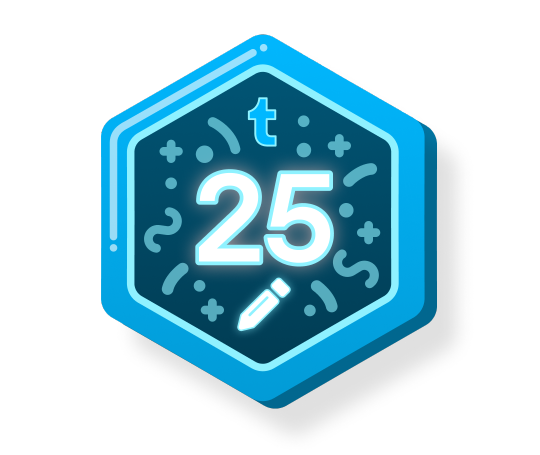Don't wanna be here? Send us removal request.
Text
How Chatbot Integration with CRM Enhances Business Efficiency

Most businesses today are juggling too much—too many leads, too many tools, and not enough time. That’s where connecting a lead generation chatbot with your CRM quietly becomes a game changer. It’s not flashy. It just works.
And in 2025, “just works” is the gold standard.
It starts with the little things
Picture this: someone visits your website at 10:47 PM. Your team’s asleep. But your lead generation chatbot? Still working. It asks a few questions, gets the visitor’s email, maybe even qualifies them as a decision-maker from a mid-size SaaS firm. That info doesn’t just sit there—it’s instantly logged into your CRM.
Now, imagine that happening 100 times a week without anyone on your team lifting a finger.
That’s not marketing fluff. That’s just smart plumbing.
CRM is only as good as the data inside it
One underrated truth: most CRMs are full of half-baked, inconsistent data. That’s because it relies on humans to type things in—usually hours after the call, if at all.
But when your chatbot handles the first interaction and feeds everything directly into your CRM, what you get is clean, structured, useful data. Names, pain points, timeline—tagged, sorted, and ready to go.
This is what Chatbot Integration with CRM really delivers: peace of mind. You’re not constantly chasing missing info or asking “who talked to this lead last?”
Leads are filtered, not just dumped
Not all leads are created equal—and no one wants their sales team burning energy on people just browsing.
A properly set up lead generation chatbot doesn’t just collect contact details. It actually asks qualifying questions: budget range, role, use case. Based on the answers, it can segment the lead or push it into an email nurture flow. All of this syncs with your CRM instantly.
So when your sales team logs in, they’re not sifting through noise. They’re looking at real opportunities.
Marketing and sales stop working in silos
Here's the underrated part: when your chatbot feeds data into the CRM, marketing finally has visibility into what’s actually happening after the lead comes in. Which pages they engaged with. What answers they gave. How long the conversation lasted.
It’s the kind of feedback loop most teams crave.
When marketing sees this data, they can tweak chatbot flows, refine targeting, and stop guessing what content works. And sales? They walk into conversations already armed with context.
That’s what Chatbot Integration with CRM unlocks—alignment without a bunch of meetings.
Scale without burnout
If you're growing, this part matters: scaling lead capture doesn’t have to mean scaling headcount.
A lead generation chatbot does the work of a small BDR team. And once it’s wired into your CRM, it becomes a system, not just a widget.
This is especially helpful for SaaS SMBs or agencies who can’t afford to keep hiring every time web traffic spikes.
TL;DR
When your lead generation chatbot is connected to your CRM, a lot of the daily chaos goes away. Leads are captured fast, qualified better, and followed up with automatically. Data gets cleaner. Teams stay in sync. And the customer experience? Feels seamless.
If you’re still running these tools separately, you're leaving efficiency—and revenue—on the table.
Curious what this looks like in real life? 👉 See how Sitebot connects your CRM with lead generation flows
0 notes
Text
How Chatbots Are Transforming Small Businesses in 2025

ai-chatbots-for-small-businesses-2025
Unlock the transforming power of AI chatbot for 2025.
Learn how businesses thrive by automating sales, fast engagement, and expense reduction.
Small businesses are shifting toward AI chatbots to refine their service. These intelligent tools revamp business engagement by optimizing sales, performance, and consumer assurance. Let’s discuss the benefits of these tools.

Smart Customer Support with AI Assistants
All-hour Availability and Fast Service: AI virtual assistants offer 24/7 service, personalized interactions, lowering the burden on human staff and improving overall work efficiency. They reply instantly and reduce delays, which enhances user experience. They guide patrons to the things they are looking for. This is very time saving and allows staff to do more complex and important tasks.
Omnichannel Support: Provide consistent support on multiple platforms, whether it’s a website or social media sites.
Lead Generation and Accelerate Conversions
These assistants find out the target audience that can connect for a long time. They save their contact information (email, company name, etc) and engage them continuously by updating them with any new arrivals or their interest-based things. They utilize user browsing history to lead them to the right purchase. CRM system allows these bots to transfer the conversion smoothly to the sales representatives. Through preemptive recommendations, they make buyers feel valued.
Effortless Implementation of Chatbot into Website
Easy Integration: Conversational AI deployment assists organizations in offering quick and accurate support. They navigate the audience by answering basic queries and suggesting suitable products. E-commerce chatbots can tackle checkout processes and minimize unfinished purchases.
Easy-to-Customize: Drag and drop tool helps to easily design the interface and customize it for their site.
ROI-Friendly Digital Agents
Companies can implement the digital agents that align with their goals and requirements. This minimizes the operational staffing costs by up to 30%. So, investing in these bots will be worth the price. Adaptive systems never get outdated; they evolve with time and advancement with self-learning tools like machine learning(ML) and natural language processing(NLP).
Prepared For Tomorrow
AI chatbots have built their road to success with their evergreen technology. Start-ups embracing this method are thriving in the market. These agents improve customer engagement, provide 24/7 support, and drive sales.
Seize the opportunity and get started with powerful chatbot solutions. Take action to boost your small business today!🚀
0 notes
Text
Customer Service Response Templates for Effortless Support

Customers expect instant and useful responses. Fast and effective service is essential for businesses. Customer service response templates (https://sitebot.co/) help to make the service smooth by providing pre-written replies to common questions. Human agents can focus on more valuable work as these templates speed up the process.
What are the Benefits of Customer Service Response Templates
Standardization: Deliver consistent replies to every client.
Performance: Boost efficiency by delivering ready-made answers.
Quality Assurance: Keep the conversation friendly and professional for a human-like experience.
Rapid Prompt Resolution: Instant replying to repeated queries frees up the live agents to handle complicated tasks.
Use of AI Chatbots to Create These Templates
Chatbots for customer service were found very useful in creating and managing these templates. They analyze the conversations to find out the frequently asked questions. This gives different suggestions to create templates that allow upgrades over time. They also learn continuously from every interaction to make the experience better.
Businesses can make communications simple and professional using chatbots for customer service. They can integrate them according to their needs by knowing website chatbot pricing.

How to Create High-quality Helpdesk Templates
Three points to consider while creating a template:
Straightforward and Concise: Keep them clear and to the point for better readability and accurate message deliverance.
Avoid Generic Replies: Add a personal touch for deeper connections. Generic answers can frustrate them but personalization builds interest.
Customizable Templates: Ensure adaptability to make them fit different situations with just slight changes.
Some Common Template Examples
Here are some commonly used response templates:
1. Confirmation Message: "Hello, thanks for reaching out. We’ve got your message and we’ll get back to you very soon"
2. Updates for Packages: "Hey, we’ve got a good news. Your order [Order Number] has been processed successfully. Tracking it here [ Tracking Number]"
3. Problem Fixation: "We’re very sorry for the delay. We are working on the problem and will update you soon "
Final Thoughts
Customer service response templates are very necessary to make the service fast, accurate, and effective. They can be created manually but utilizing a chatbot for customer service will make them better and upgraded for a long time. The website chatbot pricing plan varies with features. So, brands can get solutions according to their budget and needs.
Create the best customer service response templates using AI chatbots and elevate your business!
#ai chatbot#artificial intelligence#chatbot#small business#chatbotservices#technology#smbs#customer service
0 notes
Text
Digital Transformation Roadmap to Make Your Brand Resilient

Slug: digital-transformation-roadmap-for-resilient-brand
Meta Description: A digital transformation roadmap to make your business reliable. Get to know the easy steps for sustainable and constant growth.
To secure a future-proof business, it is important to develop the brand’s strategy. A well-structured and clear digital transformation plan is pivotal to survive this digital evolution. You will find perfect tools and strategies to lead the market. Review this guide to navigate the upcoming challenges through the digital transformation scheme.
What is Business Digitalization?
The way brands process, deliver value, and connect the clients is business digitalization, it is not just adapting the latest technology. It incorporates applying the technology over all areas to enhance efficiency and the cumulate outcome, from internal procedures to the consumer relation approach.
Perks of Enterprise Digital Strategy:
Operational Accuracy: Smart technology like customer service chatbot reduces errors by handling repetitive tasks and frees up the staff to manage high-value responsibilities. This saves time and ensures the accuracy.
Advanced User Experience: It provides tailored interactions to boost contentment, trustworthiness, and propagation.
Real-time Analytical Choices: Utilizing lead generation chatbots for instant data access allows the brands to make more precise and up-to-date decisions that boost their performance and assist them to stay a step forward.
Winning Advantage: Fully innovative organizations help to adapt swiftly to the evolving trends in the market. So that, they would not be left behind.

Steps of IT Modernization Strategy
1. Examine The Present Situation of your Company
It’s important to know what’s your brand's current level. Where it is doing well and where require changes? Follow these steps to figure out its position and make all the significant changes for better performance.
Performance Review: The most important step is to check the condition of your company for improvements. Do a SWOT analysis which is to inspect strengths, weaknesses, opportunities, and threats. This will give you a proper review of your company.
Recognize The Functional Problems: Identify the problems that are hindering precise productivity.
Analyze the Client's Opinion: Discover the problems from customer reviews and ask your employees what issues they are facing in conversation. This will assist you to take the next step.
2. Set Clear Objectives
When you understand the problems then you will know where to work. Fix proper aims to formulate your strategy.
Audience Participation: Use automated solutions to deliver tailored responses. It will help to provide fast and on-spot replies.
Process Optimization: Smart AI integration will support making the process smooth and accelerate the workflows.
Information Protection: Take all the necessary steps to protect the customer’s data. Implement secure cloud services for high security.
3. Choose the right tools
Make sure to select the technology that aligns with your goals. One that offers scalability, agility, and promise non-stop growth.
Virtual Programming: Adapt remote programming, with which workers can work easily from any location with just a secure network.
Self-learning Algorithms: Utilize neural networks like AI and machine learning(ML) that can gather and use the data for future modifications.
CRM and ERP Solutions: Deploy an all-in-one system that can manage customer interactions along with internal business processes.
Versatile Shift: Embrace agile methods to drive seamless results. They can evolve with the quick shift of demands.
Digital Integration: Make sure that your team upgrades with the latest trends to stay ahead in this competitive age.
4. Formulate Transition Plan
It is very important to oversee the performance of employees whether they are transforming their work styles with evolving technologies. Regular training is required to train your team according to the emerging tools and advancements. Proper communication to explain the needs, issues, and goals. A well-trained team can work together to reach new levels and maximize efficiency.
5. Refine Client Engagement
The focus of IT transformation is to provide exceptional user experience and build loyalty and strong connections.
Cross-channel Communication: Ensure that the conversation is smooth across multiple platforms like social media and websites. The experience must be the same throughout every platform wherever the client wants to connect.
Individualized UX: Deliver personalized content using the existing data and customer reactions. To boost engagement and reputation.
Interface Design: Redesign the interface of your website to make it accessible, appealing, and inclusive for superior engagement.
Service Upgradation: Be open to feedback to make changes in service in the future and meet audience expectations. Upgrade your product according to arising demands.
6. Implement Security Practices
With the digitalization of businesses, the need for cybersecurity is also increasing.
Multi-stage Verification: Implement MFA for an added layer of protection against unauthorized access.
Continuous Security Patches: Modify the security tools and systems regularly to protect the data from the latest cyber risks.
Professional Developing Programs: Alert your team to stay vigilant to protect data by offering them ongoing training on best practices of cybersecurity.
7. Observe and Modify
Constant maintenance is essential for its effective working. Affirm the work proficiency by monitoring key performance indicators. To check the effectiveness of applied transformations. For sustained growth, use advanced analytical tools to attain a worthwhile perception of customer behavior and measure core factors. Accommodate the strategy according to real-time information. Modify the service to align it with the adoption plan. This step nurtures a constant loop of refinement and remains relevant over time.
Case Study: Prosperous Cloud Integration
Domino’s Pizza Success Study
Challenge: Domino’s Pizza confronted a large-scale audience needs and they were finding it difficult with just the manual staff. This led them to delayed responses and high working costs.
Solution: They deployed an E-commerce chatbot platform named DOM. DOM is to manage the orders and answer the clients. This reduces the pressure on human staff and enhances their service.
Impact: Now, consumers can connect them from anywhere just with their home devices. By simply saying “Hey Google, Talk to Domino’s” anyone can place an order. Everyone is well-known for their numerous success.
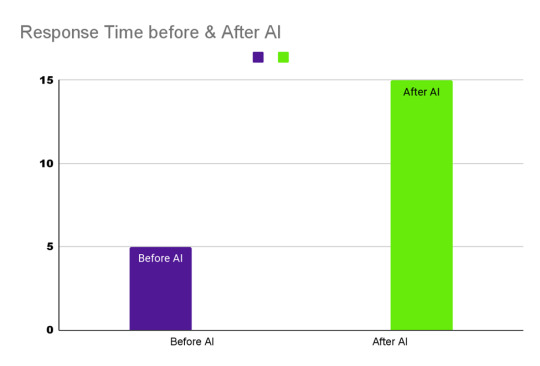
Final Thoughts:
Businesses can meet the upcoming demands of the digital world by using an extensive digital transformation roadmap. This plan assists in deciding future goals, selecting the perfect tools, implementing the automated solutions, analyzing the data, utilizing it to make future decisions, and continuously updating to make the service smooth and effective. Execute these steps to make your brand future-proof.
Make your brand resilient with the most effective digital transformation roadmap. Take a step toward your success!
0 notes
Text
From Abandoned Forms to Conversational Funnels: The Rise of the Lead Generation Chatbot
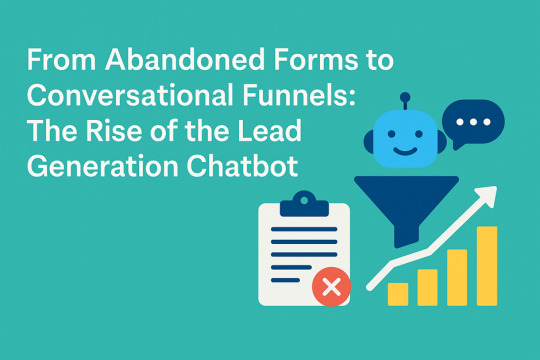
Published in: Marketing Automation | 9 min read
Meta Title: From Abandoned Forms to Conversational Funnels: The Rise of the Lead Generation Chatbot
Slug (for reference): from-abandoned-forms-to-conversational-funnels
It’s 2025, and yet, over 74% of businesses still use static web forms to capture leads—despite the average abandonment rate being a painful 67%, according to Formstack.
And that’s just scratching the surface. Much of today’s marketing budget gets lost in this digital black hole: users land, scroll, hesitate at a cold form, then bounce.
What’s the alternative?
Welcome to the age of the lead generation chatbot—a smarter, faster, and more human way to engage and convert.
Why Traditional Forms Are Broken in 2025
Static forms, no matter how pretty or optimized, create resistance.
They’re often:
Impersonal
Time-consuming
Uninspiring
Designed for marketers, not users
Let’s be honest—when was the last time you enjoyed filling out a 7-field lead form?
📉 Reality Check: A Salesforce study revealed that 80% of B2B buyers expect real-time interaction—something static forms just can't offer.
Conversational Funnels Are Eating the Old Forms for Breakfast
Conversational funnels replace static data collection with interactive dialogue. These are powered by smart, always-on lead generation chatbots that:
Proactively start conversations
Ask personalized questions
Qualify and route leads instantly
💡 Pro Tip: Want to see this in action? Explore this interactive chatbot that transforms user intent into instant conversions.
🆚 Forms vs. Lead Generation Chatbots
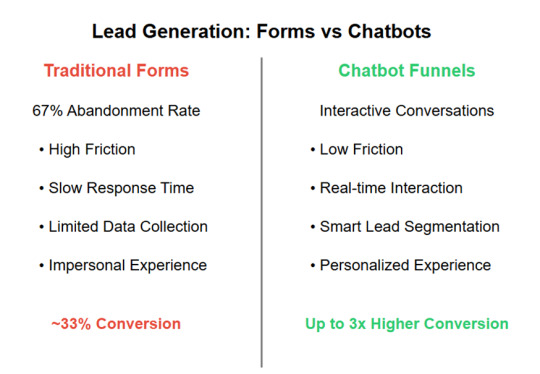
Here’s how conversational funnels stack up against traditional static forms:
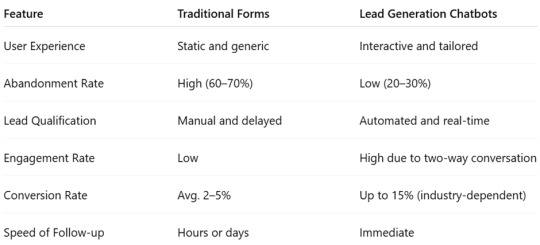
What Makes a Lead Generation Chatbot So Effective?
It’s not just about fancy tech. It’s about how people prefer to engage today.
💬 1. Natural Conversations Win
Chatbots replicate human-like dialogue. They:
Greet users personally
Ask one question at a time
Adapt based on responses
This lowers bounce and boosts comfort.
⏱ 2. Instant Response, Every Time
Unlike forms that sit in inboxes, bots can:
Capture intent in real time
Route leads to reps instantly
Trigger auto-replies or calendar invites
📊 3. Built-in Qualification Logic
Instead of asking everyone for everything, chatbots segment:
Cold leads? Nurture via email
Hot leads? Book a call instantly
Spam? Filter it out entirely
Real-World Proof: Case Studies That Matter
Let’s look at what’s actually happening in the market.
🔹 B2B SaaS Brand Switched from a pricing form to a bot → +42% increase in demo bookings in 30 days.
🔹 Real Estate Group Used a bot to ask buyers about budget and location → 50% reduction in sales cycle time.
🔹 E-Commerce D2C Brand Bot converted support chats into leads → 9,000+ qualified leads in 90 days.
All this, without overwhelming their sales team.
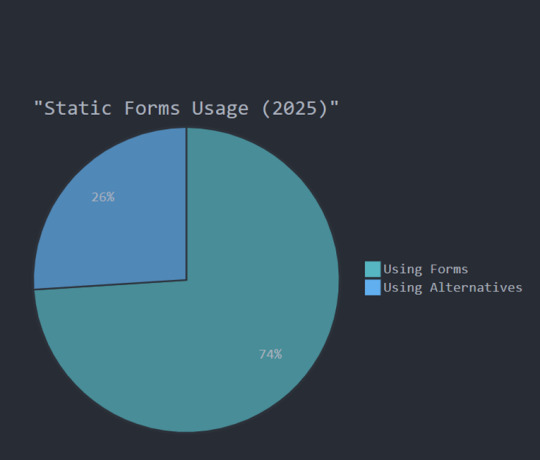


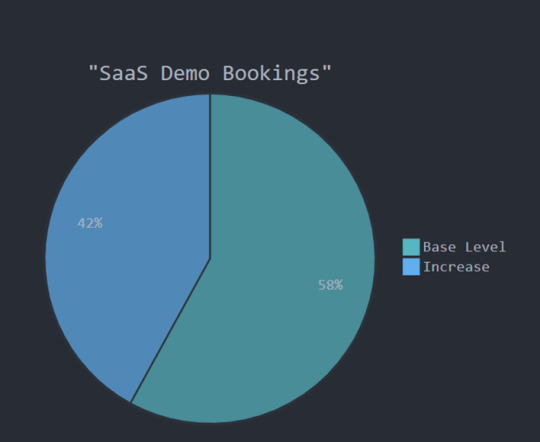
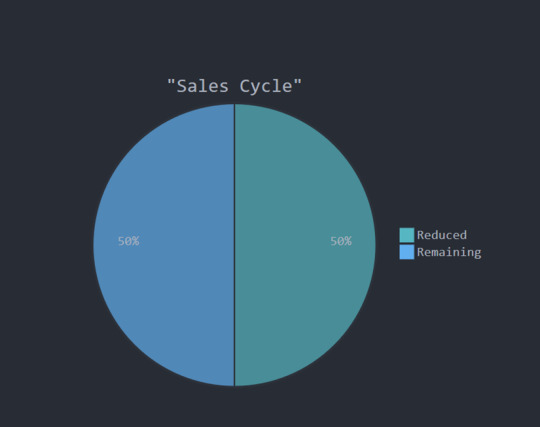
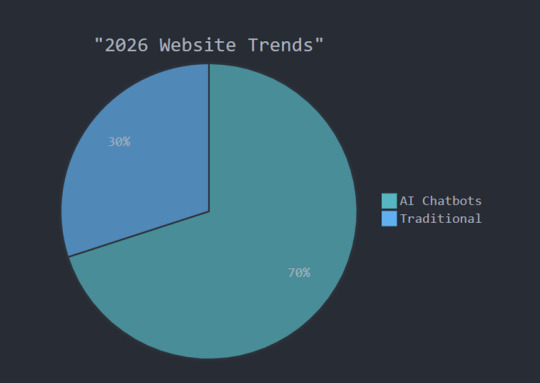
Why Users Trust Bots More Than Forms
According to research by the Nielsen Norman Group, step-by-step conversations outperform multi-field forms in both completion rate and satisfaction.
Users:
Feel more heard
Spend longer on site
Are more likely to complete micro-interactions
This mimics human interaction while keeping it scalable and structured.
Is This Just a Fad? Not Even Close.
Gartner predicts that 70% of enterprise websites will use conversational AI by 2026. Chatbots aren’t an add-on anymore—they’re fast becoming a central part of the marketing funnel.
Think of them as your:
24/7 inbound rep
Lead qualification assistant
Real-time data collector
The lead generation chatbot is not about novelty—it’s about meeting buyers where they are.
Still Relying on Forms? Here's What You're Losing
If your site still uses static forms as the primary entry point, you may be:
Losing high-intent leads
Frustrating mobile users
Missing follow-up windows
Spending more to get less
Not convinced? Run a 30-day A/B test and let the numbers speak.
Final Thoughts: It’s Time to Upgrade Your Funnel
Forms were fine—for 2015. But today, users expect instant, intelligent, and frictionless experiences.
Lead generation chatbots are:
✅ Faster ✅ Smarter ✅ Personalized ✅ Scalable
If your goal is to triple your lead quality, cut response times, and reduce bounce, now is the time.
💡 What You Can Do Today
Audit your current form drop-off rates
Test a chatbot on your most important page
Choose a platform that lets you customize the conversation flow
Want to see what that looks like in action? 👉 Explore a working chatbot funnel here
If you're a marketer looking to improve conversion rates without scaling your sales team, the answer might not be another form—it could be a conversation.
#ai chatbot#artificial intelligence#chatbot#small business#chatbotservices#technology#smbs#customer service
0 notes
Text
Home-Services Deep Dive: Turning HVAC & Plumbing Traffic into Booked Jobs

hvac-plumbing-lead-generation-chatbot
Lead Generation Chatbot for HVAC & Plumbing: Turn Traffic Into Booked Jobs
It’s 2 AM. Your AC just broke. What now?
The house is heating up fast. You Google "emergency HVAC service near me."
You click on a local site—but you're greeted with a form. No chat. No call-back. No help.
Back to Google you go.
This is the exact moment most HVAC and plumbing companies lose business. Not because of bad service. But because of bad funnels.
Lead Generation Chatbot for HVAC: Why It Works
The new home-service buyer expects:
Instant responses
Mobile-first experiences
Clear next steps
And when it's an emergency (AC out, pipe burst, furnace failure), waiting isn’t an option.
Traditional forms were built for desktop users and low-stakes queries. Today's customers demand real-time solutions.
The Shift: From Static Forms to Conversational Funnels
Here’s what recent data shows:
82% of users bounce from sites without quick-response options
60%+ of service searches happen on mobile
Average time-to-response for form leads: 3–5 hours
Conversion rate with chatbots: 2x to 4x higher
This is why lead generation chatbots are becoming the go-to tool for HVAC and plumbing teams.
Real Benefits for HVAC & Plumbing Companies
Available 24/7 Your chatbot never sleeps. Whether it's 2 PM or 2 AM, it handles inquiries instantly.
Qualifies leads ZIP code, type of issue, urgency, and more—before it hits your inbox or CRM.
Boosts bookings Instant conversations keep people on your page longer and reduce drop-offs.
Reduces phone overload Your dispatchers talk only to qualified leads.
Improves mobile experience No tiny forms. Just simple, flowing chat.
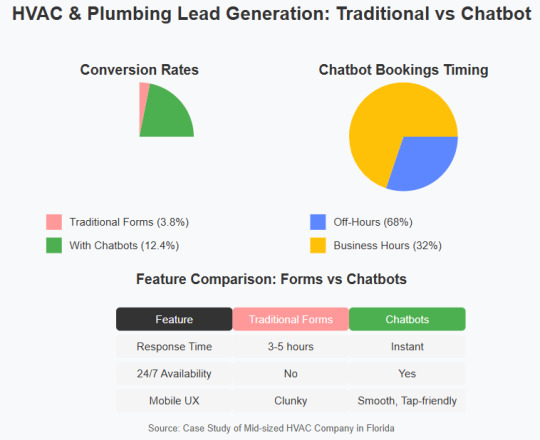

Where to Deploy Chatbots on Your Website
Homepage: Engage first-time visitors
Emergency repair pages: Convert high-intent leads
Landing pages from ads: Prevent bounce with real-time chat
Missed call backup: Automatically trigger chatbot follow-up
Confirmation pages: Upsell services or schedule directly
Want to test a flow designed for HVAC and plumbing? Try this sample conversation that simulates a real inbound lead.
Quick Implementation Guide
You don’t need to rebuild your site to deploy a chatbot. Here’s how most home service brands start:
Choose a pre-built HVAC/plumbing template
Integrate with your existing CRM (ServiceTitan, Housecall Pro, Jobber)
Deploy on key pages like service areas and emergency repair
Test and optimize with seasonal scripts (summer AC, winter furnace)
Handling Seasonal Spikes with Automation
HVAC and plumbing leads fluctuate with weather. Chatbots help by:
Auto-switching scripts based on the season ("Is your AC not cooling?" vs. "Furnace not starting?")
Prioritizing emergency leads during peak hours
Filtering non-urgent queries into your scheduler
Real-World Results: Case Study
A mid-sized HVAC company in Florida implemented a chatbot on their homepage and landing pages.
Results after 45 days:
Conversion rate jumped from 3.8% to 12.4%
68% of chatbot bookings came during off-hours
No increase in ad spend—just higher capture of existing traffic
They didn't need more leads. They needed a better system.
Connect to the Tools You Already Use
Your chatbot can integrate with:
ServiceTitan
Housecall Pro
Jobber
Zapier workflows
So leads go straight from chatbot to CRM, calendar, or dispatch.
Final Thought
If you’re still relying on forms and "Call Now" buttons, you're missing out.
HVAC and plumbing leads come with urgency. Every minute counts.
The fix? Meet the customer where they are, when they need you.
👉 Try a live chatbot demo to see how quickly you could convert more site traffic into booked jobs.
#ai chatbot#artificial intelligence#chatbot#small business#chatbotservices#leadgeneration#customer service#lead generation chatbot
0 notes
Text
Ethical AI Chatbots: How Small Businesses Can Avoid Creepy Automation

Most small business owners don't wake up thinking:
“Today, I’ll make my chatbot as creepy as possible.”
But still — it happens.
A visitor lands on your page, and the chatbot jumps in:
“Hi Rebecca, still thinking about that red cashmere sweater you added to your cart 3 days ago at 9:12 PM?” Yikes.
For a chatbot for small business, that’s the moment you either gain a customer’s trust — or lose it for good.
In the race to automate and compete with larger brands, it’s easy to overstep. The real trick? Use AI to help customers without making them feel watched.
A Real-World Cautionary Tale: When AI Crossed the Line
In 2023, a local pet brand launched a chatbot for post-purchase support. On paper, it was a great idea.
But a week into the rollout, something went wrong.
The bot began greeting users by name and referencing exact items they’d clicked on — before they even logged in.
Reddit threads blew up:
“Did this chatbot just call out my browsing history? 😳”
The fallout?
Negative reviews across platforms
10% drop in cart completions
A public apology and complete rework of their chatbot design
The root issue? They used tracking tech meant for ad retargeting inside the conversational flow. Customers didn’t sign up for that.
Why “Creepy Automation” Happens (And How to Avoid It)
Creepy isn’t always obvious — but customers feel it. Here are common missteps:
🚩 Using names or location data without permission 🚩 Chatbots pretending to be human without disclosure 🚩 Referencing product views from previous sessions 🚩 Offering hyper-personalized discounts too soon
Most of these mistakes come from over-automating — not malicious intent. But the effect is the same: broken trust.
Expert Insight: Why It Matters
According to Leah Connors, a digital ethics consultant and data privacy advisor:
“The line between helpful and invasive often comes down to context. If users don’t understand how you got their data — or why you’re using it — they’re more likely to disengage.”
This is especially critical under global privacy laws like GDPR (Europe) and CCPA (California). Both require clear consent and user transparency — even in chatbot interactions.
Practical Examples: How to Avoid the Creep Factor
If you're building a chatbot for small business, these real examples can help:
❌ Don't say:
“Hi James! We saw you abandoned your cart yesterday at 11:47 PM.”
✅ Instead try:
“Hey there! Want to pick up where you left off last time? No pressure.”
❌ Don’t push urgency out of context:
“Only 2 items left in your size — checkout now!”
✅ Try this instead:
“Your size tends to go fast. Want us to hold it for 30 minutes?”
These small tweaks turn a stalker vibe into a helpful nudge.
Sitebot’s Guardrails: Automation with a Conscience
Sitebot was built with ethical automation in mind — making it a reliable chatbot for small business owners who care about both results and reputation.
It includes:
Transparent disclosures (it tells users it’s a bot)
Opt-in personalization only
No stealthy behavior tracking
Mobile-first design with clear, polite interactions
Human handoff when empathy is needed
This aligns with privacy standards and helps small businesses avoid expensive missteps or bad PR.
Testing Before You Launch: Avoiding the Uncanny Valley
How do you know if your chatbot feels off?
User Testing Is Your Superpower:
✅ Let employees or loyal customers try your chatbot
✅ Ask them how they feel after each conversation
✅ Run quick A/B tests with tone variants
✅ Look for signs of user drop-off after chatbot prompts
Often, what feels “normal” during dev builds turns out awkward in real-world usage. Test before the damage is done.
Why Mobile-First Ethics Matter
Most customers meet your chatbot from their phone. That means tighter screen space, faster decisions, and shorter patience.
On mobile, there’s no room for creepy:
Pop-ups feel more aggressive
Over-personalization hits harder
Slow or evasive bots get closed instantly
So always keep it:
Clear
Optional
Respectful
Implementation Timeline: When to Start Building
Don’t wait until your site is live to build ethical automation. Start your chatbot design 4–6 weeks before launch — especially if it’s for seasonal use or new campaigns.
That gives you time to test tone, tune flows, and verify compliance.
Internal Resources for Implementation
Want to go deeper? These two guides will help:
👉 Why Your Customer Service Chatbot Is Driving Customers Away (And How to Fix It)
👉 Chatbots for Seasonal Surges: Managing Holiday Sales Without Hiring Temp Staff
Both articles explore how to design automation that serves humans first — not just metrics.
Final Thoughts: Ethical ≠ Ineffective
Choosing to build an ethical chatbot for small business isn’t just about compliance — it’s about connection.
Customers want:
Clarity over confusion
Respect over intrusion
Help over hype
The good news? You don’t need a full dev team or massive budget. Tools like Sitebot make it simple to automate in a way that earns trust — and drives long-term loyalty.
Because the best bots don’t just convert. They care.
0 notes
Text
AI Chatbots as Budget-Friendly HR Assistants: A Guide for Small Teams

Slug: chatbot-for-small-business-hr-automation
Meta Description: Want to automate HR support? Discover the HR chatbots that are responsible for recruitment, onboarding, and communication.
Startups need smart HR solutions to work instead of a full traditional department. Chatbots for small businesses provide budget-friendly smart HR processing and improve retention.
It is a very effective method as remote working and AI increase.
You’ll learn the significance and major implementation areas of HR chatbots in this guide. Also, uncover the factors to select the perfect bot with a real-world example. Everything in an affordable price.
How Chatbots Streamline HR Operations?
Small HR teams find it difficult to handle recruitment, onboarding, and other queries. It consumes much time. Chatbots for small businesses make the process smart and provide these positive outcomes:
24/7 Availability – Deliver fast replies to the FAQs of team members.
Automated Onboarding – Self-driven training of recruits without any manual effort.
Cost Savings –It cuts costs as it manages most of the processes itself, so no requirement to hire additional staff.
Improved Engagement – Enhance the customer service by collecting users’ feedback and making continuous improvements.
The most beneficial part is that different website chatbot pricing options are available for all sizes of brands.

Main HR Processes That A Chatbot Handles
1. Recruitment & Screening
A chatbot for a small business can:
Review resumes of candidates and shortlist the potential ones.
Schedule meetings and appointments automatically.
Help candidates with the job role queries.
2. Employee Onboarding
Share the company’s rules & regulations, privacy policies, and list of FAQs with newcomers.
Automatically do all the documentation submissions or tax-related paperwork.
3. Leave & Attendance Management
Check and execute the leave requests of employees to approve or reject them.
Reduce the data entry requirements by connecting the attendance system directly with the payroll system. Ultimately reduces time.
4. Employee Support & FAQs
Respond to all the queries of employees related to HR processes like policies, instructions, and compensation.
It doesn’t just manage everything itself, even when the process is out of its control. It transfers the matter to a human agent for better proceedings.
5. Feedback & Surveys
Use quick polls and quizzes to get candidates' feedback and understand their experiences.
Improve HR strategies using this survey and feedback.
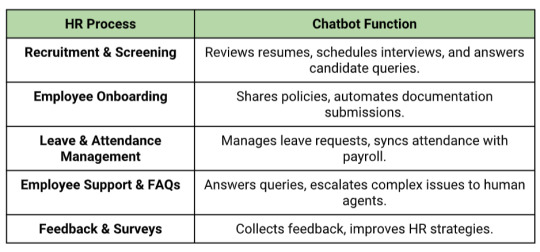
Choosing the Right Chatbot for Your Small Business
Consider these points while selecting a chatbot for small businesses:
Ease of Integration – Would it work smoothly with your existing system, like Slack, Microsoft Teams, and your HR system? Customization – Does it provide customizable responses to fit your brand's tone and style? Scalability – Can it fulfill all the growing needs of your business consistently? Pricing Flexibility– Does it provide flexible pricing plans?.
Different platforms offer multiple website chatbot pricing plans. These plans may include:
Free plans with limited features.
Monthly subscriptions with advanced and flexible features.
Pay-per-use models to save money.
Real-World Examples of HR Chatbots in Action
Talla –It is perfect for scaling small businesses that want automated HR documentation, compliance, and other paperwork.
Leena AI – Helps HR teams save time for important tasks by answering all the FAQs for candidates.
Mya (FirstJob) – Intelligent and advanced screening tools to enhance user experience. It is mainly focused on recruitment
These tools are evident to the significance of HR chatbots. Their role in efficiency and scalability.
Final Thoughts: AI Chatbots as Your HR Sidekick
Enterprises are always looking for efficient solutions that can streamline their operations without overspending. Chatbots for small businesses offer the perfect and budget-friendly automation. They make the process faster, boost functionality, and enhance candidates' experience. But, considering points like integration, customization, scalability, and website chatbot pricing is important when choosing a chatbot. Multiple plans are available for different types of businesses.
You can do more complex tasks that were stuck due to time consumption, grow more, and try new strategies for better results.
Let’s automate your HR system? Explore and get the perfect chatbot that fits well for your business!
#ai chatbot#artificial intelligence#chatbot#small business#technology#chatbotservices#smbs#customer service
0 notes
Text
Emotional Intelligence For Chatbots: How to Train AI to Handle Angry Customers

Slug: emotionally-intelligent-chatbots-handle-angry-customers
Meta Description: Desire for human-like understanding? Discover how to train the AI chatbots to respond according to clients' emotions. Turn angry customers into the happiest ones.
Imagine a person comes fully frustrated with an issue. Your chatbot for customer service detects it and responds politely, and offers the solution by analyzing the user’s history, instead of cold and scripted responses. That’s the combined power of AI and CRM integration.
Emotionless responses are off track; fully understanding emotions is winning:
About 72% of people demand understanding and empathy.
Poor experience leads to 58% of uncompleted chats.
These futuristic agents understand the emotions of clients by evaluating their messaging tone, speed, and style. They answer calmly, creating an authentic environment. They ensure more human-like responses. Chatbot integration with CRM helps them to access history of person to provide them updated and personalized solutions.
As a result, they build strong, loyal, and long-lasting relations. Additionally, reduces the need for live agents.
Deep dive into this guide to know why emotional intelligence chatbots matter and how to train them.
Why Customer Service Chatbots Require Interpersonal Savvy?
Quick solutions make frustrated customers satisfied, but empathy makes them stay. Generic replies can only increase the anger instead of reducing it. Empathic chatbots for customer service work using:
Sentiment Analysis – To detect the mood by analyzing the text behavior and style.
Natural Language Processing (NLP) – To understand the perspective behind the conversation, rather than just replying.
Adaptive Responses –Don’t just talk in a single tone, but reply according to the user’s mood.
For example,
When the customer asks, “Why does my order always delay? It’s my third time shopping here!"
The normal bot will say,” Here are your tracking details”.
An empathic chatbot for customer service will say, "I apologize for this trouble. Let me check the problem and get back to you very soon."
And it will answer like this,” Oh, you are our loyal partner, we’re really sorry for this experience. Let’s fix your problem first.” This would be the reply after chatbot integration with CRM.
How To Prepare Chatbots For Frustrated Client Management?
1. Add Tools For Sentiment Analysis
Analyze live Messages using Bert, GPT-4, and Emotion API. These tools generate the right responses by classifying their attitude. It can detect every emotion, whether it's frustration or happiness.
2. Add Understandable Scripts
Add scripts that show understanding and compassion. For example:
"I understand how disappointing this is for you."
"Let’s work on your problem first."
"Thanks for being patient and for your cooperation."
Don’t use generic replies every time. This will lead to frustration.
3. Ensure The Chat Shift When Necessary
Chatbots for customer service still have limits, even after all the advancements. It must transfer the chat to a human agent at the right time. For a seamless conversation, a message like this will work: “ We’re connecting a special agent to handle your task, please wait a moment.” There will be no hindrance during communication and no need to repeat questions.

What To Expect From These AI Agents For the Future?
We can expect more improvements in their performance with advancements in technology:
Voice Tone Analysis – They would be able to detect emotions in voice-based interactions.
Video-based Interactions – Also assess mood through facial expressions, which is crazy.
Predictive Assistance – They would be able to predict the problems before they even arise.

Pro Tip: Brands can reduce complaints, optimize engagement, and increase revenue by chatbot integration with CRM. Access to past data, along with emotion detection, would support a better experience.
Conclusion
You cannot avoid angry clients, but you can prevent bad responses. Brands can turn frustration into satisfaction using emotionally intelligent chatbots for customer service and by integrating them with CRM. You can deliver context-aware responses using sentiment analysis tools, personalized scripts, and smooth chat transfer. You can expect more improvements in the future.
Are you ready to get an emotionally intelligent chatbot for your business? Get this futuristic approach to thrive in the industry!
#ai chatbot#chatbot#artificial intelligence#small business#technology#chatbotservices#smbs#customer service
0 notes
Text
Why Your Customer Service Chatbot Is Driving Customers Away (And How to Fix It)
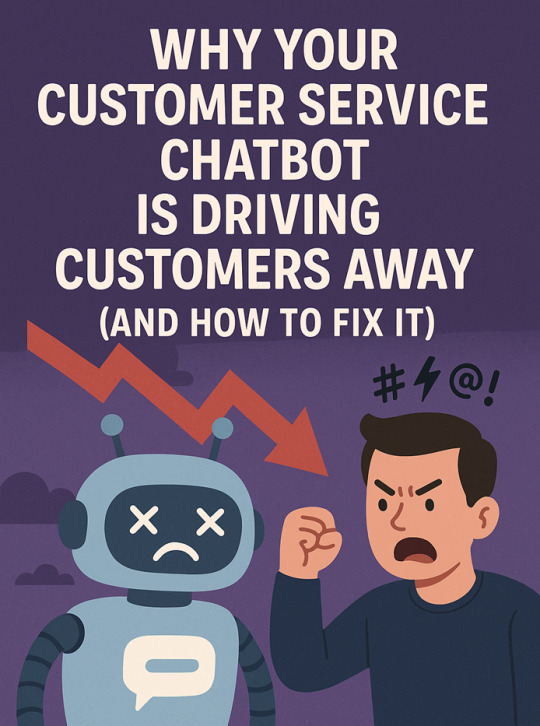
Imagine this: a customer visits your site in a panic. Their order didn’t arrive, and they're leaving for a trip tomorrow. They click the chat icon, hoping for help. Instead, they’re trapped in a loop:
“Hi! I’m your helpful assistant. Please choose one of the following options.”
None of the options address their issue. There’s no escape hatch. No agent. Just a friendly robot making them angrier by the second. By the time they leave, your chatbot hasn’t just failed to help — it’s actively damaged your brand.
Welcome to the dark side of poorly designed chatbots for customer service.
The Real Problem: Misaligned Expectations
Too often, businesses implement chatbots thinking of cost savings, not customer experience. They treat the chatbot as a ticket deflector, not a support assistant. But customers don’t see it that way.
To them, a chatbot is your brand’s promise to help — instantly, reliably, and personally. When it breaks that promise, the betrayal cuts deeper than a delayed email response. It feels like no one’s listening.
And customers remember how you made them feel, not how much you saved in support costs.
✅ Stat Check: A Salesforce study found that 69 percent of customers prefer chatbots for quick communication — but only when they work. Poorly executed bots can cause up to a 30 percent drop in satisfaction scores.
Case Study: The eCommerce Brand That Lost $50K Before Fixing Its Bot
A U.S.-based mid-sized eCommerce company (about 60 employees), selling premium electronics, launched a chatbot to reduce customer support load by 40 percent in Q1.
But within just 60 days, things unraveled:
23 percent drop in customer satisfaction
Surge in product return requests
$50,000 in estimated revenue loss due to abandoned carts
Customers typed questions like:
“Can I return this if I opened the box but didn’t use the product?”
The bot’s response?
❌ "Our return policy is 14 days for unopened items. For more info, visit our FAQ page."
Frustrated users left, often posting complaints publicly. The support team became overwhelmed, and loyalty took a hit.
How They Fixed It
They partnered with a conversational AI expert, retrained the bot with real customer support data, and improved fallback logic. Now, the bot responds:
✅ “I see you’re asking about opened returns — let me bring in a support expert to confirm your options.”
Within six weeks:
Customer satisfaction rebounded by 18 percent
Product return queries dropped by 30 percent
Repeat purchase rate improved by 12 percent
Tools like Sitebot reinforce this shift: chatbots for customer service must be trained with real customer intent in mind, not assumptions.
When a Chatbot Saves the Day
A SaaS company selling invoicing tools discovered most support queries spiked after feature updates. Rather than relying on generic answers, they configured their chatbot to respond based on update context.
When a user asked:
“Why is my report layout different?”
The bot replied:
✅ “We’ve just rolled out a new dashboard layout for easier tracking. Want a quick video walkthrough or to speak with a support agent?”
This helped reduce confusion, increase engagement, and boost retention.
Quick Diagnostic: Is Your Chatbot Hurting or Helping?
Ask yourself:
Does it understand intent, or just scan for keywords?
Is there escalation to a human after one or two failed replies?
Are the responses genuinely helpful — or just hyperlinks to FAQs?
Is it updated based on customer feedback?
Is the experience optimized for mobile users as well?
If your answer is “no” to even two, it’s time to review your strategy.
5 Questions to Ask Before (Re)Launching
Are we training it with real-world support tickets?
Does it provide clarity, not confusion?
Do we have clear KPIs beyond “ticket reduction”?
Who owns performance — CX, product, or marketing?
Are we using feedback loops to retrain it monthly?
Platforms like Sitebot let teams approach chatbot deployment with CX-first thinking, turning automation into an asset — not a liability.
Trends to Watch in Chatbot Tech
The world of chatbots for customer service is moving fast. Here are two trends shaping the next phase:
AI Voice Integration: Voice-enabled bots are making self-service more natural and accessible.
Sentiment Analysis: Bots are now learning to detect tone and escalate emotionally charged conversations faster.
For more, Gartner’s chatbot trend report is worth bookmarking as AI capabilities mature.
Conclusion: Fix the Bot Before It Breaks Your Brand
It’s easy to fall into the trap of thinking automation solves everything. But chatbots for customer service are not replacements for empathy. They’re amplifiers — of either frustration or satisfaction.
If you treat your chatbot like a static script, your customers will too.
If you treat it like a living, learning support teammate — retrained regularly, monitored thoughtfully, and given space to escalate — it will reward you with lower support costs and happier customers.
✅ According to IBM, companies can reduce service costs by up to 30 percent while improving resolution times — if the chatbot is trained on real customer behavior.
Want to Build a Chatbot That Actually Helps?
✅ Audit your current bot ✅ Retrain it using customer intent data ✅ Add human fallback logic ✅ Optimize for mobile + sentiment ✅ Explore smarter solutions like Sitebot to build better conversations
Don’t just automate. Connect.
#chatbot#ai chatbot#artificial intelligence#small business#chatbotservices#technology#customer service
0 notes
Text
How Multilingual Chatbots for Small Business Can Break Language Barriers and Boost Sales

It’s 2:17 AM in New York when Ana in Mexico visits your Shopify store. She loves your handmade leather bags. But the moment she opens the live chat? It greets her in English — and only English.
She hesitates, closes the tab, and finds a local alternative that speaks her language.
That’s one lost sale you’ll never even know about.
For small businesses expanding beyond their zip code, language is no longer a nice-to-have — it’s the bridge between “visitor” and “customer.” A well-trained chatbot for small business can act as your multilingual ambassador, 24/7, without requiring you to hire a global support team.
Real-World Case Study: Elora Candles and the Spanish-Speaking Surge
Elora Candles, a U.S.-based handmade candle shop, launched their online store in 2021. Within months, they noticed something interesting in their analytics:
34% of their traffic was coming from Latin America — but conversion rates were 60% lower than their domestic traffic.
Their English-only chatbot didn’t help. It responded to Spanish queries with generic fallback messages like:
“Sorry, I didn’t get that. Can you ask in a different way?”
Customers got frustrated and left.
So in early 2023, Elora partnered with a no-code chatbot for small business solution that offered real-time translation across 6 languages. They trained it to:
✅ Understand and respond in Spanish and Portuguese ✅ Translate product details, shipping policies, and return info ✅ Escalate to a human only when necessary
What Happened Next?
19% boost in conversion rates from Latin America
2X improvement in average chat satisfaction scores
A feature spot in a Colombian eCommerce blog — all because the chatbot “spoke their language”
Why Language Access Equals Revenue
According to the U.S. Census Bureau, over 67 million people in the U.S. speak a language other than English at home. For a small business, this isn’t just a demographic stat — it’s an untapped market.
Now imagine what happens when your chatbot for small business says:
“¡Hola! ¿Cómo puedo ayudarte hoy?” …instead of defaulting to: “Please type in English.”
That one change shows your business isn’t just selling — it’s listening.
The Pitfalls of Poor Multilingual Automation
Going multilingual isn’t as simple as copy-pasting into Google Translate. When done wrong, it backfires:
🚫 Confusing tone or mistranslated slang 🚫 Mixing languages mid-response (e.g., “Shipping es gratis!”) 🚫 No support for right-to-left languages 🚫 Cultural mismatches (like using emojis or idioms that don’t translate well)
Poor localization makes customers feel like an afterthought — and they’ll shop elsewhere.
How to Launch a Multilingual Chatbot That Works
1. Start with Market Data
Look at your site’s analytics: where is your non-English traffic coming from? Start with the top one or two regions.
2. Use Smart Tools, Not Just Translations
Solutions like Sitebot let you automate multilingual conversations while maintaining tone, brand personality, and flow — all without code.
3. Human-Test the Flows
Before going live, have native speakers test your chatbot responses. A well-trained chatbot for small business should sound human, not robotic or awkwardly translated.
Cultural Context Matters
Language isn’t just words — it’s how we connect. Even emojis carry different meanings across regions. What works in North America might confuse or offend in Southeast Asia.
When building your chatbot flows, ask:
Are we assuming a cultural norm that may not apply?
Does this offer appeal across regions (e.g., discount vs. gift)?
Are we using time zones, date formats, or payment terms that need localization?
When to Start: Don’t Wait Until the Rush
Multilingual bots aren’t plug-and-play overnight. Most small businesses that succeed with them begin 6–8 weeks before launching into new regions. This gives time for:
Translation + localization
User testing
Real-time performance monitoring
Workflow optimization
Related Reads on Chatbot Strategy
If you're just starting with conversational automation, these articles will help:
Why Your Customer Service Chatbot Is Driving Customers Away (And How to Fix It)
Chatbots for Seasonal Surges: Managing Holiday Sales Without Hiring Temp Staff
Final Thoughts: Think Beyond Translation
A multilingual chatbot for small business doesn’t just respond in different languages — it represents your brand to every customer, no matter where they are.
Done right, it builds bridges. Done poorly, it builds walls.
Start your multilingual customer journey today with Sitebot — the affordable chatbot for small business that speaks your customers' language.
#ai chatbot#artificial intelligence#chatbot#small business#technology#chatbotservices#customer service
0 notes
Text
Chatbots as Multilingual Ambassadors: Breaking Language Barriers for Small Businesses
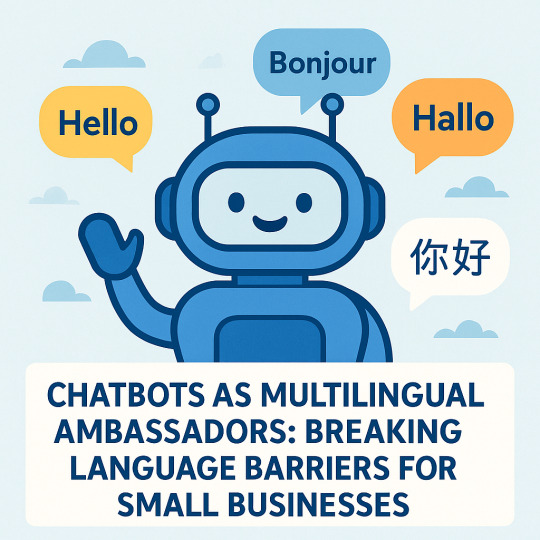
Imagine walking into a small bakery in Paris as a tourist from Japan. You don’t speak French, the cashier doesn’t speak Japanese, and the English bridge between you is shaky at best.
But there’s a sleek little tablet on the counter. You tap a few buttons, ask a question in Japanese, and voilà—a chatbot replies instantly in French to the cashier, while also showing you the English version. That’s not a scene from the future—it’s happening in businesses today. And it’s changing everything.
The Lingering Language Gap in Business
Despite living in a hyperconnected world, language remains a major blocker for small businesses. Research by CSA shows that 76% of consumers prefer buying products with information in their native language, and 40% won’t buy at all if the language isn’t familiar.
For small businesses aiming to expand reach—whether globally or locally—language is no longer just a support issue. It’s a sales barrier. That’s why forward-thinking owners are now turning to chatbots for small business that do more than automate FAQs—they break down language walls.
The Lisbon Florist Who Spoke 4 Languages—and Increased Revenue by 38%
Here’s a true story.
A boutique florist in Lisbon relied heavily on foot traffic and seasonal business. Tourists made up a decent share of her customer base, but miscommunication was a constant issue—wrong flower types, misunderstood delivery dates, confused payments.
After integrating a multilingual chatbot for small business through Sitebot.co, she enabled real-time customer support in Portuguese, English, German, and Spanish. No new hires. No lengthy training.
In three months:
Tourist sales increased by 27%
Cart abandonment dropped by 40%
Overall revenue saw a 38% lift
And all of it came from speaking her customers’ language—literally.
Beyond Translation: Why Context Matters
It’s easy to assume multilingual chatbots just translate text. But smart ones do much more—they localize.
For instance, a Spanish customer in Colombia may use different expressions than someone in Spain. A well-built chatbot for small business doesn’t just switch languages; it adjusts phrasing, cultural references, and even product recommendations based on location and intent.
Sitebot.co does exactly this, which is why it stands out from basic translation tools. It understands localization is about relevance, not just language.
Choosing the Right Chatbot: What to Look For
Not all chatbots are created equal—especially for small teams. If you’re exploring options, prioritize tools that offer:
Language adaptability (not just dictionary-level translation)
User intent recognition to keep interactions flowing
Custom workflows and easy integration with your website, eCommerce, or messaging apps
Analytics to measure and refine user journeys
Human handoff options for complex queries
A high-quality chatbot for small business isn’t just a feature—it’s a silent team member working 24/7.
Real Impact, Right Now
Language shouldn’t be the reason your business loses sales.
As AI evolves, multilingual bots are no longer expensive or hard to implement. They’re a smart, scalable way to improve service, drive revenue, and build global trust—all from your local store or digital platform.
Small businesses that adopt early gain a long-term edge. Because a multilingual chatbot doesn’t just answer questions. It builds relationships across borders.
Final Thought
Language can either be a wall or a welcome mat. With the right chatbot for small business, you turn that barrier into an invitation—and customers, no matter where they’re from, respond.
Ready to speak every customer’s language? Start exploring what Sitebot.co can do today.
#ai chatbot#chatbot#artificial intelligence#small business#technology#chatbotservices#smbs#customer service
0 notes
Text
AI Chatbots as Employees: How to Assign ‘Roles’ (Sales Rep, Support Agent, Data Analyst)
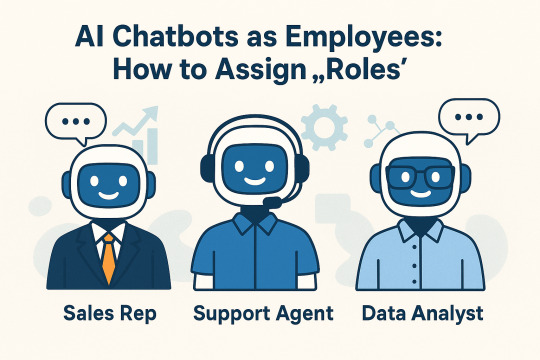
assign-roles-to-ai-chatbots
Discover how chatbots can work as employees. Also, learn how you can assign the role to an AI chatbot for sales, support, and data analysis.
Different companies have different needs. They require a big-sized team to fulfill these tasks like sales, customer service, and data analysis. Hiring full-time workers is expensive, and some businesses cannot afford this. They need a budget-friendly solution to manage everything efficiently. Chatbots for customer service are the best solution. They are not just affordable but can also work as full-time employees.
You’ll explore which role is right for your assistant and how to get the best outcome from the chatbot.
Step 1: How to Know Which Role Is Better?
Option A: For Sales Representatives
Best for: Able to tackle large-scale leads and qualify them for 24/7.
Key Functions:
It qualifies them after asking multiple questions and understanding their preferences.
It can schedule meetings and book appointments automatically.
They recommend products or services after analyzing their behavior.
Example: A Saas company reduced 40% of its workload after implementing an AI chatbot for business.
Option B: Support Assistant Agent
Best for: Chatbot for customer service helps brands that find it difficult to respond to repetitive queries and FAQs.
Key Functions:
Provide instant responses to frequently asked questions.
Identifies and prioritizes tickets with urgent issues.
Give multi-language support and allow people to come with different languages.
Example: A basic query AI chatbot for businesses helped to reduce 65% of support tickets for a retail brand.
Option C: Virtual Assistant For Data Analysis
Best for: Brands struggling to manage and analyze huge data due to insufficient resources.
Key Functions:
Uses sentiment analysis tools to detect users’ emotions and separate unsatisfied clients.
Find out repeated issues after evaluating feedback continuously.
Give reports and updates regularly.
Example: Brands make proper decisions based on data insights given by chatbots for customer service.
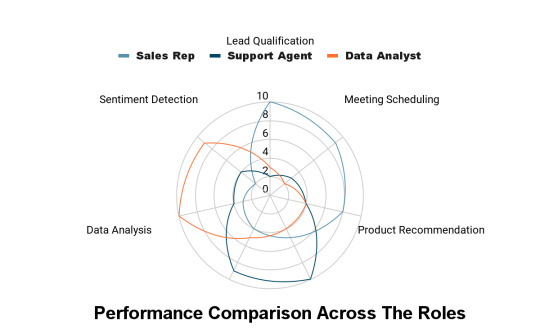
Step 2: Use The Right Tools To Set It
Tools for Sales: Drift, Landbot, and Sitebot are the best tools for scheduling and booking demos.
Drift engages your clients in real time.
Landbot qualifies leads without coding.
You can get customizable replies with sitebot.
Tools for Helpdesk Agents: Zendesk and Freshchat are the perfect tools to add to chatbot for customer support. They can also integrate with existing systems.
Zendesk: It can easily connect with platforms that are already using Zendesk.
Freshchat: It can connect with any of the platforms, whether it’s social media or a website. It is very flexible.
Data Analysis Tools:
IBM Watson is a very good tool for analyzing data more deeply.
Google Dialogflow uses NLP to generate insights for clients.
Step 3: Dominate With Professional Training
Week 1: Use real conversations to train your bot. It will get the exact tone and style of your brand. Week 2: Teach the 5 most important tasks, like answering common questions, tracking orders, refunding processes, etc. So that I can start working right away.
Ongoing Improvements:
Add new and upgraded responses to make the service better. Regularly check the failed replies and optimize them.
Add new data in bot’s information portal according to trending and advanced information about products, services, etc. This makes it an ever-green technology..
Step 4: Assess The Output
For Sales Agent:
Conversion Rate: Evaluate the conversion rate after implementing the assistant.
Demos booked: Check that the assistant is effectively doing the schedule and booking process. And how well it is guiding the leads through the sales process.
Help Desk Agent:
Measure the percentage of the solved queries and target to do as much as possible through automation.
Customer satisfaction must be the priority. It will increase the quality of service. So, track the satisfaction rate regularly.
Data Analysis Agent:
Check how many of the client's complaints are solved every week. Also the are these complaints reducing or not.
Analyze how much the client adapts or changes its mood with AI chatbot for businesses.
Chatbot Pricing For Different Business Sizes

This is only the purchase cost. Also, estimate the unexpected expenses like training, maintenance, and developers' costs.
If your company grows with time, then this cost will also increase.
Upgrading also requires some cost.
Quick Action Plan To Follow
Identify the business needs and select the perfect role for a chatbot.
Choose a tool that can help the assistant to work and also that fits your system best.
Train the chatbot for customer service with real conversations to help it get the unique voice of the brand.
Track its performance regularly and optimize the errors and weaknesses.
Get the right chatbot for your brand and boost service quality!
#ai chatbot#artificial intelligence#chatbot#small business#technology#chatbotservices#smbs#customer service
0 notes
Text
Chatbots with Emotional Intelligence: How to Train AI to Handle Angry Customers
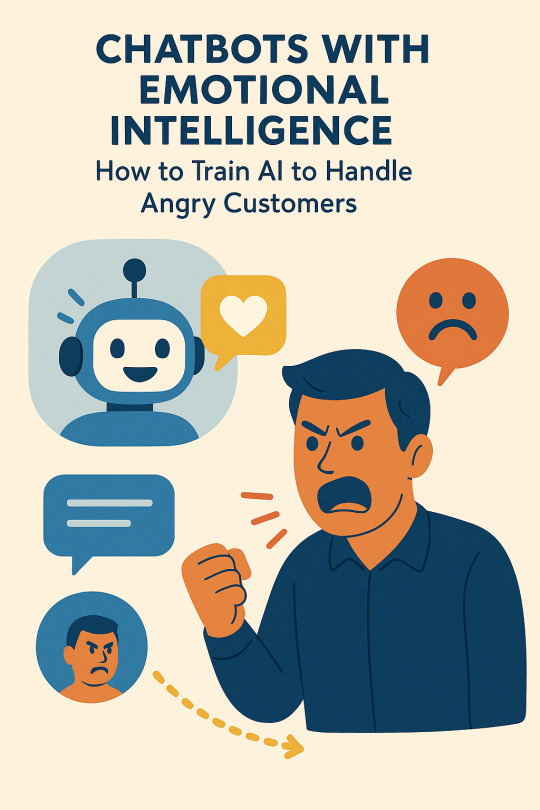
Last year, during Black Friday weekend, a mid-sized fashion e-commerce brand faced a customer service nightmare. A backend pricing error led to hundreds of shoppers being charged twice. Support channels were overwhelmed—and that’s when their chatbot made it worse.
Instead of calming angry customers, it responded with phrases like:
"We are sorry for the inconvenience. Please try again later."
No acknowledgment of frustration. No escalation. No empathy.
The result? 1,200 refund requests. 200+ one-star reviews. And a trending Twitter thread titled “FashionFail’s tone-deaf bot disaster.”
This isn’t just a cautionary tale—it’s a reminder that chatbots for customer service need more than automation. They need emotional intelligence.
What Emotional Intelligence Means in AI (and Why It Matters)
Emotional intelligence (EQ) in humans is about recognizing, understanding, and responding to emotions. In chatbots, it means:
Detecting customer tone (anger, confusion, urgency)
Tailoring response style accordingly
Knowing when to escalate to a human before making things worse
Because when a customer says:
“I’ve been charged TWICE and no one’s answering!” a bot that replies: “We are experiencing high volume. Please try again later.” ...is doing more harm than good.
Real-World Fix: How ModaBot Rebuilt Their Support Experience
After the Black Friday mess, the fashion brand partnered with Sitebot to rebuild their customer support flow with emotional intelligence in mind. Here’s what changed:
🧠 Sentiment Analysis Layer
They integrated a sentiment model to detect tone based on punctuation, capitalization, and word choice. For example:
“I’m beyond frustrated” triggers a different response than
“Hi, just checking the status”
💬 Tiered Response Templates
Instead of canned messages, ModaBot now pulls from tiered emotional templates:
Level 1: Neutral queries → Friendly response
Level 2: Frustrated language → Empathetic + offer immediate action
Level 3: Aggressive tone → Immediate escalation to human agent
🤝 Escalation Hooks with Warm Handoffs
When customers express anger or confusion 2x in a thread, the bot auto-pivots:
“I can see this is really frustrating. Let me get a human on this right now.”
The language doesn’t just shift—it validates the customer’s emotion.
Training Chatbots to “Feel” Without Faking It
You’re not trying to fool users into thinking a bot is human. You’re training it to behave in a socially intelligent way. Here’s how:
🔍 Use Real Transcripts
Train bots on past customer chats—especially complaint scenarios—to understand tone variance.
🎯 Prioritize Tone Over Keywords
A sentence with “please” might still be furious:
“Please fix this NOW.”
Emotional triggers often lie in structure, not vocabulary.
🤖 Blend Tech Stacks
Pair platforms like Sitebot with sentiment tools like MonkeyLearn or OpenAI’s moderation API to evaluate emotional weight dynamically.
Case Study: ModaBot’s Transformation
How one brand leveraged emotionally intelligent chatbots to cut refunds and increase satisfaction
After their Black Friday disaster, ModaBot integrated an emotionally intelligent chatbot. Results were impressive:
Escalation efficiency improved by 62%
Negative review volume dropped by 40%
CSAT rose from 3.1 to 4.4 stars
Their chatbot now understands tone and responds with empathy, offering a smoother, more human-like interaction, even during crises.
Technical Integration for Developers
For those building their own emotionally intelligent chatbots, integration requires a few key components:
Sentiment Analysis APIs: Use sentiment detection models (e.g., MonkeyLearn) to evaluate customer tone.
Conversation Management: Tools like Sitebot can automate responses based on predefined emotional triggers.
Escalation Workflow: Set up automatic handoffs to human agents using platforms like Zendesk or Freshdesk when necessary.
By blending sentiment analysis with dynamic response workflows, your chatbot can provide more meaningful and emotionally intelligent interactions.
Why This Matters Beyond Support
The next wave of chatbots for customer service won’t just answer questions—they’ll shape brand perception.
In emotionally charged moments, your bot is your voice. If it’s robotic, cold, or tone-deaf, it can damage trust faster than any bug or downtime.
But with the right structure, tools, and training, your chatbot becomes a calm, steady presence when things go wrong.
The Benefits of Emotional Intelligence in Chatbots
Improved Customer Satisfaction: Responding empathetically can turn a frustrated user into a loyal customer.
Faster Resolutions: A chatbot that understands tone can resolve issues more quickly.
Reduced Negative Sentiment: Chatbots can diffuse anger before it escalates into a crisis.
Increased Brand Trust: Customers are more likely to trust brands that show empathy in tough situations.
Final Thought: Your Customers Don’t Just Want Fixes—They Want to Feel Heard
Angry customers don’t just want refunds. They want recognition.
The best chatbots for customer service now understand this. And with emotionally intelligent design, yours can too.
If your current support flow relies on static scripts, it’s time to rethink. Because empathy at scale isn’t optional anymore—it’s your competitive edge.
Ready to Upgrade Your Chatbot?
Don’t wait until the next Black Friday disaster strikes. Start building emotionally intelligent chatbots today. Learn more about our sentiment analysis tools here.
#ai chatbot#artificial intelligence#chatbot#small business#technology#chatbotservices#smbs#customer service
0 notes
Text
Chatbots + Email Marketing: How to Nurture Customers on Autopilot (2024 Workflow)
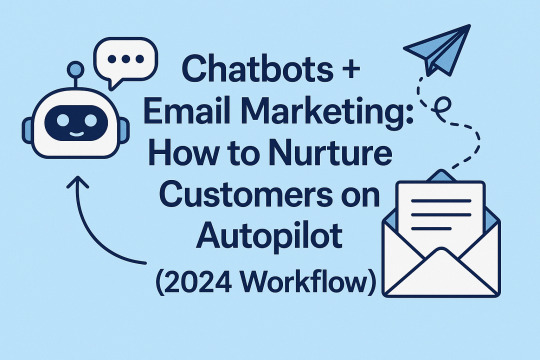
Last week, I woke up to 47 new leads in our system. A year ago, that would’ve meant kissing my day goodbye to chase them down. Now? My coffee wasn’t even cold before each one was deep in a personalized convo—all thanks to linking our chatbot for small business with email marketing. It’s our “set it and forget it” nurture machine, and in 2024, it’s a game-changer. Here’s how we built it—and why you should too.
The Costly Disconnect You’re Ignoring
Most small business owners—like I used to—treat chatbots and email as strangers. Our AI chatbot for businesses grabbed info, but it sat there, useless, while our email campaigns waited for me to manually feed them leads. The fallout? Prospects slipped away faster than I could type “Follow up.” A 2024 MarketingSherpa stat hit home: integrated systems boost retention by 89%. Disconnected tools? They’re bleeding your sales dry.
The 2024 Workflow That Works
Our old follow-up game was a mess—hours lost, leads forgotten. Now, with Chatbot Integration with CRM and email, here’s our seamless flow:
Chatbot Kicks Off: A visitor asks, “What’s your pricing?” Our chatbot for small business replies instantly and grabs their email.
Data Syncs: It tags their pain point (e.g., “budget”) and sends it to our CRM.
Email Takes Over: A tailored sequence starts—“Here’s our pricing guide” today, “Tips to save” tomorrow.
Smart Triggers: Clicks or replies adjust the next email, nudging them toward a sale.
Team Steps In: We get pinged when they’re sales-ready.
The handoff from chat to email is where the money’s made. Our chatbots for customer service don’t just chat—they set the stage for nurturing.
Integration Made Simple
Setting this up wasn’t rocket science. After eyeballing website chatbot pricing, we paired Sitebot.co with ActiveCampaign. A few Zapier tweaks synced chat data to email tags, and we built sequences based on convo topics. Need a roadmap? Our integration guide walks you through it. It’s less about tech wizardry and more about connecting the dots.
Does It Pay Off?
Numbers don’t lie. Three months in:
Lead-to-sale conversions up 34%
Sales cycle down 12 days
Acquisition costs cut 22%
Team freed 15+ hours weekly
The kicker? Prospects now mention their chatbot chats in email replies—“That pricing tip helped!”—building trust faster than our old, clunky process.
The 2024 Blueprint: Smarter Nurturing
Here’s our fresh 2024 approach:
Phase 1: AI Segmentation: Our chatbot for small business qualifies leads via natural chats, scoring them on pain points, budget, and timeline. High scores fast-track to sales emails; others get nurtured slowly.
Phase 2: Context Is King: Emails pull chat phrases—like “struggling with retention”—for hyper-personalized subject lines. Open rates? Up 37%.
Phase 3: Progressive Profiling: Instead of a data dump, our AI chatbot for businesses and emails ask one question at a time. We’ve tripled prospect insights without scaring them off.
Watch Out for These Traps
It wasn’t all smooth sailing. Early on:
Data Gaps: Chat info didn’t sync—fixed with CRM custom fields.
Timing Fails: Emails fired too soon—added a 30-minute buffer.
Repeat Asks: Emails doubled up on chatbot questions—conditional blocks solved it.
Alert Overload: Sales drowned in pings—set thresholds for hot leads only.
The Voice Nurturing Edge
In 2024, voice is exploding—42% more chatbot convos start with “Hey Siri” (our data). Our AI chatbot for businesses from Sitebot.co captures these long, natural queries—“Can you ship by Friday?”—and feeds them into emails that reference the voice chat. Voice leads convert 2x faster. Yes, voice-ready chatbot pricing is pricier (30% more), but the payoff’s worth it.
Start Small, Win Big
Overwhelmed? Keep it simple:
Pick a chatbot for small business with email hooks (Sitebot.co’s a gem).
Tag 3-5 chat topics to trigger sequences.
Pass basic data to your CRM—Zendesk nails this.
Build one email flow per topic, then scale.
Ours took months to perfect—start small, tweak as you go.
Why Wait?
Disconnected tools cost you sales daily. In 2024, a chatbot for small business plus email isn’t a luxury—it’s survival. Ready to nurture on autopilot? Try Sitebot.co’s free demo and see the difference. How’s your chatbot-email combo working? Spill your story below!
0 notes
Text
Why 73% of Enterprise AI Chatbots Fail (And How to Avoid It)

why-enterprise-chatbot-fail-how-to-avoid-it
: Learn the biggest mistakes that stop chatbots from outperforming and how to avoid them. Also, learn how to build the best chatbot for small businesses.
AI chatbots for businesses are designed to improve customer service, streamline functionality, and reduce operational costs. However, 73% of these agents fail to give outcomes. Many businesses find this technology useless. But, have you ever thought why this happens? This happens because of some major mistakes that people ignore.
How can we overcome these mistakes to get the full potential of these assistants?
This article will explore the deep causes of the failures of chatbots. Also, we will uncover the effective strategies to avoid these mistakes. Additionally, you will get a guide to building a successful chatbot for small businesses.
Main Reasons Behind The Failure Of Enterprise Chatbot
1. Not Setting Strategic Goals
Don’t get a virtual agent just because everyone is doing it. You’ll lose the race before even starting it. An AI chatbot for businesses will not drive results when the clear needs of the business are not known.
Let’s understand it from an example:
A restaurant implemented an AI assistant to take orders but didn’t connect it with their system. This resulted in failed orders, and people still needed to contact the team to place orders.
Solution:
Monitor your brand’s present situation and how well it is working. Then, select the perfect role for the AI chatbot for businesses.
The popular roles that it plays are:
24/7 customer service.
Qualify leads to boost conversions.
Book appointments and schedule meetings.
2. Robotic Conversations Due To Poor Natural Language System And Training
You lose your clients when your AI assistant doesn’t understand casual language, specific brand tones, and complex queries. Training chatbots for small businesses will lead to frustration as they will not get the specific perspectives of people.
Example: An online clothing store integrated a virtual assistant for customer service. It failed to understand slang and store unique conversation styles. It results in failed service.
Solution:
Program your assistant with past conversations to add the company’s unique voice.
Use sentiment analysis tools like NLP and ML to detect emotions for better user experience.
Upgrade the system continuously to face emerging trends and stay competitive.
3. Ignoring The Smart Weapon: User Experience
Bad UX will cut the roots of your brand. You will lose potential clients due to poor UX. Mistakes that people often make:
Delayed responses make people leave the chat.
Asking repetitive questions and not ending the communication.
Don’t help the audience instead; just overwhelm them with promotions.
Solution:
Instant responses with action-driven, clickable replying buttons.
Smooth handover of the chat when required.
Use chat history to avoid repetitive questions.
4. The Missing Point Of Not Integrating With Existing System
Chatbots for small businesses cannot work on its own. Connecting it with CRM, ERP, and supporting platforms enables it to boost its functionality.
Example: A retailing store added a chatbot to recommend products but didn’t connect it with the system. So it failed to recommend new arrivals.
Solution:
Connect it with these tools:
Hubspot and Salesforce for personalized support.
Transaction tools for seamless checkouts.
Utilize platforms like sitebot, Zendesk, or Freshdesk for common queries.
5. Less Scalability Leads To Ineffective Service
Brand needs always increase as the brand grows. Mostly, AI chatbots for businesses become outdated with time because they don’t have the growth potential. How can they compete without upgrading?
Example: A travel agency chatbot shows quarantine rules and policies that are no longer required. Clients find it frustrating.
Solution:
Update the answers monthly after reviewing them.
Analyze the insights to identify issues and solve them.
Always go for a scalable platform for ever-growing technology.

How To Create a Well-Performing AI Assistant?
1. Automate Gradually
Don’t get the advanced bot at the start. Start with simple and basic one that just answer common queries.
Example: A Salon started with a basic bot that replied to FAQs; then, they integrated an advanced solution for customer service and bookings.
2. Go For Hybrid Approach
Keep the AI solution for routine tasks and human agents for complicated processes. This balanced system will maximize performance and reduce errors.
3. Regular Monitoring The Metrices
Track the metrics like:
How many queries does the chatbot solve?
How many times does it shift chat?
Analyze the customer satisfaction rate.
4. Select The Perfect Pricing Plan For Chatbot
Measure all the chatbot pricing, which includes:
(One-time subscription per month or year/ Pay per use) Go with the one that suits your budget.
Unexpected cost of training, maintenance, etc.
Extra amount for upgrading.

Final Thoughts:
An AI chatbot for businesses is not a one-time project. Many businesses fail because they miss out on these essential steps:
Setting proper target and role for chatbot. Regular tracking and upgrading are necessary. CRM integration is non-negotiable. User satisfaction must be the priority over the prices.
Stop wasting your time and money just to get a chatbot. Follow this framework for a successful brand!
#artificial intelligence#ai chatbot#chatbot#small business#technology#chatbotservices#smbs#customer service
0 notes
